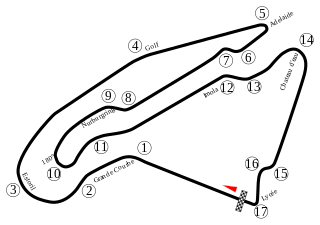Minardi was an Italian automobile racing team and constructor founded in Faenza in 1979 by Giancarlo Minardi. It competed in the Formula One World Championship from 1985 until 2005 with little success, nevertheless acquiring a loyal following of fans. In 2001, to save the team from folding, Minardi sold it to Australian businessman Paul Stoddart, who ran the team for five years before selling it on to Red Bull GmbH in 2005 who renamed it Scuderia Toro Rosso. From 2001, all of Minardi chassis were called "PS" then a number, the PS being the initials of team owner, Paul Stoddart.

Christian Fittipaldi is a Brazilian former racing driver who has competed in various forms of motorsport including Formula One, Champ Car, and NASCAR. He was a highly rated young racing driver in the early 1990s, and participated in 43 Formula One Grands Prix for Minardi and Footwork between 1992 and 1994.
Arrows Grand Prix International was a British Formula One team active from 1978 to 2002. It was known as Footwork from 1991 to 1996.

The 1991 French Grand Prix was a Formula One motor race held at Magny-Cours on 7 July 1991. It was the seventh race of the 1991 Formula One World Championship, and the first French Grand Prix to be held at Magny-Cours. The 72-lap race was won by Nigel Mansell, driving a Williams-Renault, with local driver Alain Prost second in a Ferrari and Ayrton Senna third in a McLaren-Honda.

The 1991 Australian Grand Prix was a Formula One motor race held on 3 November 1991 at the Adelaide Street Circuit. It was the 16th and final race of the 1991 Formula One World Championship. Torrential rain resulted in the race being stopped after just 16 of the scheduled 81 laps had been completed. The official results were declared from the end of the 14th lap, two laps before the race was suspended, in line with regulations. It held the record for being the shortest Formula One World Championship race ever held until the 2021 Belgian Grand Prix, which was stopped on the third lap, with results declared after one lap, equivalent to 6.880 kilometres (4.275 mi)

The 1992 Monaco Grand Prix was a Formula One motor race held on 31 May 1992 at the Circuit de Monaco. It was the sixth race of the 1992 Formula One World Championship.
The 1992 Canadian Grand Prix was a Formula One motor race held at Circuit Gilles Villeneuve on 14 June 1992. It was the seventh race of the 1992 Formula One World Championship.

The 1992 Belgian Grand Prix was a Formula One motor race held at Spa-Francorchamps on 30 August 1992. It was the twelfth race of the 1992 Formula One World Championship.

The 1992 Japanese Grand Prix was a Formula One motor race held at Suzuka on 25 October 1992. It was the fifteenth race of the 1992 Formula One World Championship.

The 1993 Italian Grand Prix was a Formula One motor race held at Monza on 12 September 1993. It was the thirteenth race of the 1993 Formula One World Championship.
The 1994 Belgian Grand Prix was a Formula One motor race held on 28 August 1994 at the Circuit de Spa-Francorchamps, near the village of Francorchamps, Wallonia. It was the eleventh race of the 1994 Formula One World Championship.

The 1997 FIA Formula One World Championship was the 51st season of FIA Formula One motor racing. It commenced on 9 March and ended on 26 October after seventeen races. The Drivers' Championship was won by Jacques Villeneuve and the Constructors' Championship was awarded to Williams-Renault.

The 1994 FIA Formula One World Championship was the 48th season of FIA Formula One motor racing. It featured the 1994 Formula One World Championship for Drivers and the 1994 Formula One World Championship for Constructors, which were contested concurrently over a sixteen-race series that commenced on 27 March and ended on 13 November. Michael Schumacher won his first Drivers' Championship driving for Benetton, while Williams-Renault won their third consecutive Constructors' Championship, the seventh in all for Williams.

The 1993 FIA Formula One World Championship was the 47th season of FIA Formula One motor racing. It featured the 1993 Formula One World Championship for Drivers and the 1993 Formula One World Championship for Constructors, which were contested concurrently over a sixteen-race series that commenced on 14 March and ended on 7 November. Alain Prost won his fourth and final Drivers' Championship, and Williams-Renault won their second consecutive Constructors' Championship, the sixth in all for Williams.

The Jordan 191 was a Formula One car designed by Gary Anderson for use by Jordan Grand Prix in its debut season in 1991. Its best finish was in Canada and Mexico, where Andrea de Cesaris drove it to fourth place at both races. Driving the 191 at the 1991 Hungarian Grand Prix, Bertrand Gachot took the fastest lap of the race.

The Lola LC88 is a Formula One car that the Larrousse team used to compete in the 1988 and one race in the 1989 Formula One season. It was an evolution of the previous LC87 model, except for major changes to the front suspension.
The Ligier JS37 was a Formula One car designed by Frank Dernie and Gérard Ducarouge and built by the Ligier team for the 1992 Formula One season. The car was powered by the Renault RS3 V10 engine and ran on Goodyear tyres.

The Dallara F192 was a Formula One car designed by Gian Paolo Dallara, of Dallara, and used by the BMS Scuderia Italia team during the 1992 Formula One season. The car was powered by the Ferrari V12 engine and ran on Goodyear tyres.

The Minardi M191 was a Formula One car designed by Aldo Costa and Rene Hilhorst and built by Minardi for the 1991 Formula One season. The car was powered by the Ferrari V12 engine and ran on Goodyear tyres. Its best finish in a race was 4th (twice).

The HB is a series of 3.5-litre, naturally-aspirated V8 Formula One racing engines, designed, developed and produced by Cosworth, in partnership with Ford; and used between 1989 and 1994. The customer engines were used by Benetton, Fondmetal, McLaren, Lotus, Minardi, Footwork, Simtek, and Larrousse.















